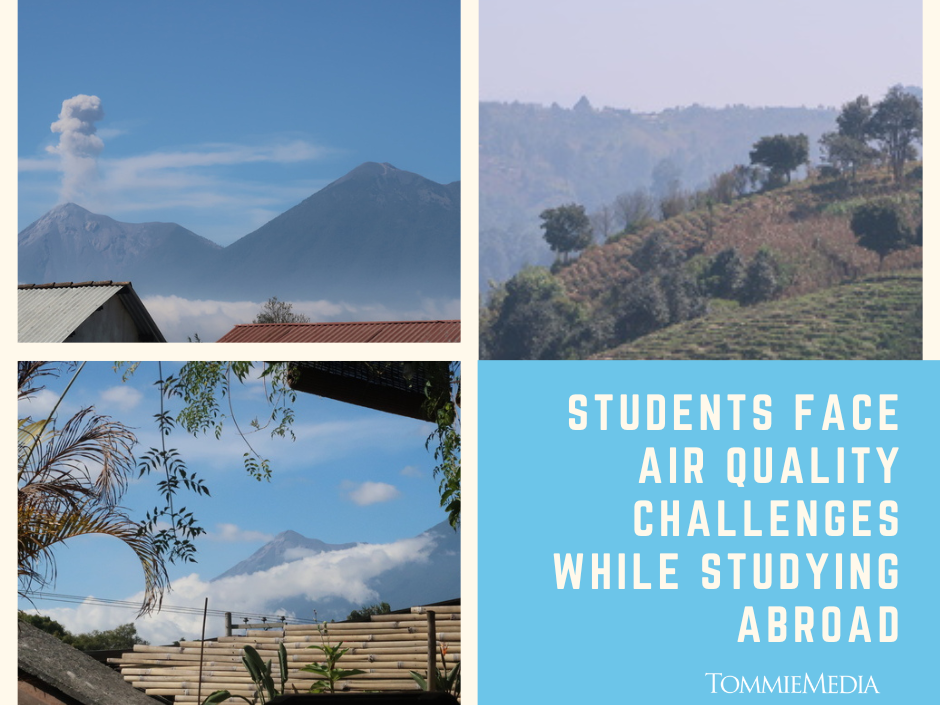
On average, 1,000 students from the University of St. Thomas study abroad each year with programs in over 50 countries.
These countries vary in culture, religion, geography and more, but one thing often left undiscussed is the difference in air quality.
When I studied in Antigua, Guatemala, over J-Term, I observed the high levels of exhaust and the initial effect it had on my well-being.
While catalytic converters are legally required in Guatemala, the majority of the cars I saw there did not have them. They reduce carbon emissions by over 90%.
When I asked my Spanish teacher in Guatemala why air pollution was such a large problem, she told me water contamination is the country’s priority.
According to the US Army Corps of Engineers, the country’s water contamination problem can be attributed to domestic wastewater and agricultural runoff.
Other students studying abroad have also observed poor air quality, including junior Isabella Caswell, who is studying abroad in Florence, Italy this semester.
“Up until this past weekend, the air quality in Italy has been in the red zone for weeks,” Caswell said. “It has smelled smokey, and the city has looked hazy.”
Caswell said that the poor air quality has affected her travel.
“I went hiking up a mountain in Florence last weekend when the air quality was in the red zone, and it made the hike more difficult,” Caswell said. “It was smokey, the air was thick and I was having trouble breathing properly. The view of the city down below was also obstructed by smog, so it was almost like the hike wasn’t worth it.”
Senior Julia De Broux had similar air quality concerns when she studied in Rome over J-term and said that she worried about her health.
“I was actually kind of freaked out a few days before leaving because my mom told me to pack masks because of the air quality,” De Broux said. “Considering I have asthma in my family, I packed them just in case.”
When De Broux arrived in Italy, the differences in air quality to Minnesota became apparent to her, similar to Caswell.
“You could tell there was pollution when driving in different areas, especially at night,” De Broux said. “It was kind of smokey at times. There was almost a smog feel. If you were in a really dense, populated area, you could often see haze.”
Despite all of the visible smog and haze in Italy, both De Broux and Caswell found the air quality at times similar to the United States.
“The U.S. has had bad air quality before. In fact, I believe every summer in Minnesota there has been at minimum hazy skies for a few week periods. This past summer there were awful days where a majority of the U.S., including Minnesota, was in the purple zone and it wasn’t breathable,” Caswell said. “The bad air quality in Italy wasn’t necessarily something that stood out to me because I am used to it, and I’ve normalized it.”
The average air quality index in Italy is 50.32, while in the United States, it is 28.45. However, during the summer of 2023, the AQI in Minnesota exceeded one hundred for over a week, leading to the hazy skies described by Caswell, even in Italy. The air quality index considers a level below 50 as healthy. However, in Italy, many cities have AQI values exceeding 50, resulting in an overall average above this threshold.
The air quality in Italy can be attributed to its rapid industrial growth. Since the 1990s, Italy has become one of the top carbon dioxide producing countries.
Caswell, De Broux, and I are concerned about the state of our environment after experiencing unhealthy air.
Many countries like Guatemala lack the funding to address air quality when water quality is its priority. Although air quality is a quieter environmental issue, addressing water quality remains a higher priority on the country’s agenda, given its direct impact on the daily lives of citizens.
While not a current priority in some countries, it is important to draw attention to issues like air quality. Air pollution, according to the World Health Organization, is cited in excess of seven million premature deaths globally each year. This contributes to a range of health issues, including pulmonary and heart diseases, lung cancer, and respiratory infections.
“Obviously, our planet is sick,” De Broux said. “We have to figure out some ways to fix that.”
Cecilia Wallace can be reached at wall1238@stthomas.edu.
